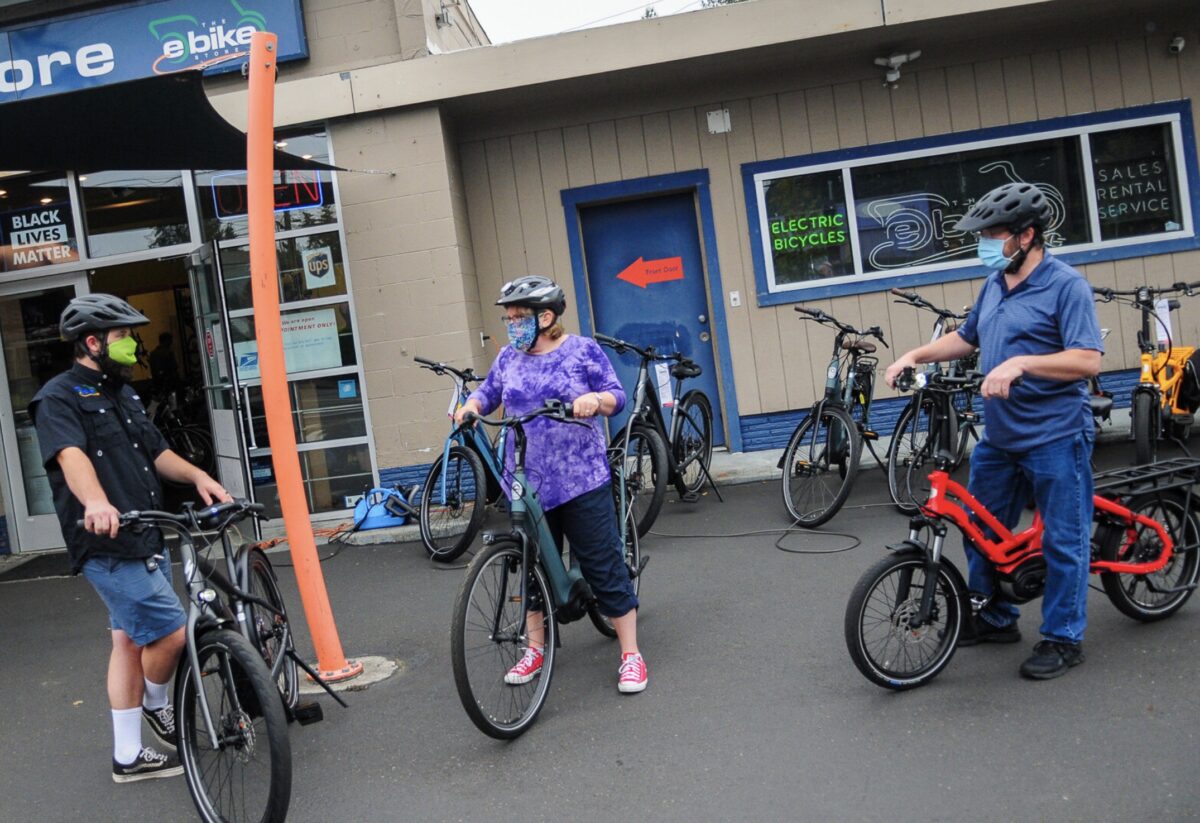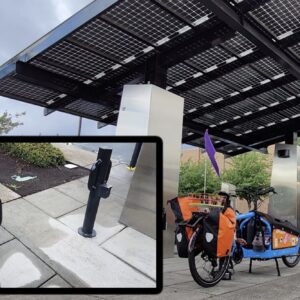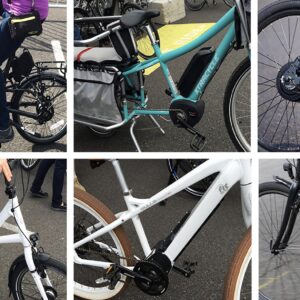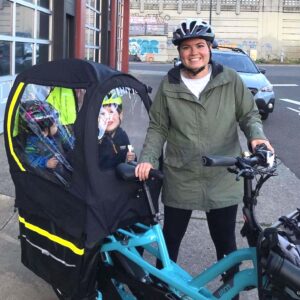
(Photo: Jonathan Maus/BikePortland)
“There’s still a belief that biking is recreational, not utilitarian.”
— John MacArthur, Portland State University
The electric bike industry is taking off in the U.S., spurred in part by the pandemic bike boom and a growing awareness about sustainability and the transportation sector’s impact on climate change. As I shared in a recent BikePortland article, my interest in e-bikes has piqued over the last year or so, and I’m now planning to be one of the hundreds of thousands of proud electric bicycle owners in the U.S. (more details on that journey coming soon!).
But even though the data looks promising, and the media has caught wind of the enthusiasm, there are still several things holding back the e-bike tide according to local experts we talked to. First, policymakers need more hard data and research to get on board. We also need safer streets. Despite the added power, stability, and other features (like always-on lights) that can make e-bikes safer, traffic safety concerns loom large in the minds of would-be riders. And finally, some people are put-off by a lingering anti e-bike cultural stigma.
Do those things sound familiar? Remove the “e” and you see it’s a similar set of issues that have long plagued analog bikes in America.
John MacArthur, the Sustainable Transportation Program Manager at Portland State University’s Transportation Research and Education Center (TREC) — and a nationally-known e-bike expert — says that having more information about how people ride their e-bikes is crucial if we expect government to give them subsidies on par with EV cars (the lack of EV-bike subsidies in Oregon, compared to cars, is very stark). If researchers can prove that increased e-bike ridership reduces people’s vehicle miles traveled (VMT), thereby lowering their individual carbon emissions, there’s a reason for governments to incentivize buying them.
If just 15% of urban transportation miles traveled were made by e-bike instead of cars, carbon emissions could be reduced by 12%
“There’s still a belief that biking is recreational, not utilitarian,” MacArthur says. “For state and local jurisdictions to put dollars toward these programs, they want to see that there’s an intended benefit they’re empowered to meet.”
But the electric car craze still dominates the conversation when it comes to reducing carbon emissions via transportation, proven by the ghosting of bikes and sole focus on car charging stations in the Biden Infrastructure Bill. Cars are so ingrained into the American ethos and urban design that those in the e-bike industry say it’s hard for many people to imagine being able to replace their car with a bike.
Thanks in part to Portland’s very own Congressman Earl Blumenauer, the idea of subsidizing e-bikes has made its way into policy talks. As Blumenauer is quick to point out, wide e-bike usage has known positive environmental impacts. A study, co-written by MacArthur and PSU’s Michael McQueen says that if just 15% of urban transportation miles traveled were made by e-bike instead of cars, carbon emissions could be reduced by 12%.
But the bikes can be pricey — an entry level model will run you at least $1000, but you can easily spend far upwards of $2000 — especially when you have to shell out all the money at once. Blumenauer’s bill has gone through some changes since it was first introduced, but as it currently stands in the federal Build Back Better bill, it would give people up to $900 in tax credits on purchases of e-bikes up to $4000, giving people a pretty significant financial incentive to buy a new set of wheels.
However, e-bikes are still being referred to by some as a “niche” element of the proposed Build Back Better package, that looks to have a pretty bumpy road to passage, so it will be important to communicate the benefits of e-bike ridership that researchers have found and continue funding more research on the topic.
“There’s a huge need for research, because there are still a lot of questions,” MacArthur shared with us in an interview this week. In a November 22nd article in Bicycle Retailer & Industry News, MacArthur said, “We just don’t know very much. The numbers we have are not very accurate.” He points to a particular gap in sales data for the vast amount of e-bike purchases made during the pandemic.
Advertisement
Even if there was a subsidy, there are other problems to address when it comes to encouraging e-bike ridership.
Nick Wood, the marketing manager at Portland-based e-mobility company Vvolt, says that he thinks improving cycling infrastructure so people feel safe is the top way to get people on e-bikes.
“Without on-street safety as a significant priority, I don’t think we’ll be able to accelerate the everyday transportation use of e-bikes in a meaningful way. When we talk about what it’s going to take to make e-bikes appropriately popular, that’s probably the biggest thing,” Wood says. “We’re super excited about subsidies and public charging infrastructure from the state or the feds, but those things are only so effective in the absence of properly safe and connected infrastructure.”
“There has to be a pretty big sea change in order to make people feel comfortable.”
— Eva Frazier
“So many people could be riding a bike instead of driving a car,” says Eva Frazier, co-owner of Portland bike shop Clever Cycles. But Frazier acknowledges since cities are primarily designed for cars, there are valid reasons for people to feel anxious about making the switch over to bikes of any kind. “There has to be a pretty big sea change in order to make people feel comfortable,” she says.
Frazier thinks de-incentivizing driving — or pointing out how it is often faster to ride a bike than sit in rush-hour traffic — can give people the push they need to get on an e-bike.
To MacArthur, more funding for research on how people use e-bikes — whether they’re just for weekend fun or to replace the family car — is crucial.
Even if we prove that e-bikes will take a chunk out of greenhouse gas emissions and even if we make our cities more welcoming to them, some advocates say it’s crucial that people abandon any competitive or haughty mindset that treats analog bikes as superior to e-bikes.
“You just have to get over your prejudices.”
— Nick Wood, Vvolt
“We need to understand that a bike is to move people, and it’s about that movement,” MacArthur says. “People have to stop thinking about themselves. Bicycling is not a sport, it’s not a race, it’s just movement of yourself around town.”
Nick Wood, the marketing manager at Portland-based e-mobility company Vvolt, says that if people are serious about getting cars off the streets, they’ll embrace all forms of active transit.
“At the end of the day, the question is: do you want more people to drive or would you rather have more people engaging in some form of active transportation? If you’d like to see more people in automobiles, I’d like to hear your solutions for solving some of society’s biggest problems,” Wood says. “You just have to get over your prejudices.”
Despite these factors holding back e-bike ridership and the research limitations he’s bumped into, MacArthur says that he doesn’t think the e-bike boom is a fad. The question is how sticky is this,” MacArthur says. “There are lots of different factors to consider, but I think it’s here to stay.”





Thanks for reading.
BikePortland has served this community with independent community journalism since 2005. We rely on subscriptions from readers like you to survive. Your financial support is vital in keeping this valuable resource alive and well.
Please subscribe today to strengthen and expand our work.
I feel like maybe this is a frog in the slowly boiling pot scenario in some ways, regarding people recognizing the popularity of ebikes. I moved from Portland to a suburban area on the East Coast 4 years ago. Upon moving back to Seattle this summer I have been absolutely shocked at the high prevalence of ebikes here. I would say some days they’re 50% or more of the bikes I see out on the road! I would guess ebikes are especially popular here due to all the hills (that’s one of the big reasons we bought one)
Cost is definitely an issue (as is safe storage/parking for many), but I think we’re on our way to really seeing the ebike boom.
The study looked at passenger transportation emissions, not aggregate sector-based emissions or even total transportation emissions. The 12% drop would actually be a meager ~3% drop in sector-based emissions in Portland. Moreover, the underlying assumption of 15% miles traveled by e-bike requires something like a 20-25% cycling mode share (e-bikes are used for shorter trips than SUVs/trucks so a higher mode share is required to generate the same VMT).
My e-bike commute is 15 miles one way (so 30 miles per day). What’s this you’re saying about shorter trips? That’s not a ride I’d want to do on a regular bike. Not just the distance, but the amount of gear I carry and the terrain means I’d be whipped. Are you focused on the bike shares? Why? The general populace could replace their single use automobile with an e-bike and we’d be winning big. That’s what the data says – the stuff you’re trying to shrug off.
Next time please read and think about my comment prior to responding.
First of all, the 12% drop in emissions was only for the subset of Portland’s transportation emissions that involves passenger vehicles (read the study that Taylor cited). A ~12% drop of ~45% of Transportation Emissions which represent ~40% of Portland’s sector based emissions is approximately a 3% drop in aggregate GHG emissions (using Portland’s metrics). This is hardly “winning big”.
Secondly, I estimated that the average e-bike trip would be 10 miles (a generous estimate) but a large fraction of Ecocidal SUV trips are far longer than this (S. Jones cited the BTS stats below, google is your friend). This means that for e-bikes to replace 15% of VMT a significantly higher bike mode share would be required. I would love to see Portland have 25% bike mode share but the likelihood of this happening within a time frame that would keep us under 2 C is asymptotically close to zero.
I won’t respond to any additional comments you may make.
Statements like this:
… belie the data. Statistics on bts.gov indicate that replacing 15% of VMT is a far greater ask than it seems.
While a large percentage of 1-way trips up to 250 miles in the U.S. are shorter and e-bikeable — 66% are 5 miles or below, 80% 10 miles or below — that does not hold true for trip distance: 12% of VMT is for trips 5 miles or below, 24% for 10 miles or below.
Attempting to replace 15% of VMT is not even possible if we consider 5 miles the 1-way trip max. If we extend it to 10 miles it would require 63% of trips up to 10 miles be made by bike or e-bike.
Of course, these ratios are certainly different from one urban area to the next, but the general rule and hurdle it represents still holds.
If travelers replace longer trips with shorter trips (e.g. the distribution of trips changes) it is certainly possible but would still require a very high cycling mode share. I think the real issue with this ridiculously optimistic math is that the impact of something like 25% mode share on aggregate sector-based emissions would still only amount to reduction of a few percent. And, of course, any analysis that focuses on sector-based emissions is a form climate crisis denial. (The USA consumes a quarter of all goods produced but is only 4% of the world population.)
E-Bikes have their good and bad uses. Good: people giving up their car and commuting by e-bike. Bad: in Bend, the guy going 25 mph on the hiking trail on his e-fat bike weaving in between hikers, kids, dogs on leashes…or the guy going 35 mph in the bike lane and zooming by 15 mph regular folks. I se many issues with the types of people that buy e-bikes, btw I live in Bend, where commuting by bike is a very tiny demographic. I see many e-bikers treating their machines much like unregulated motorcycles, not bicycles.
Yep, keep class 2s and class 3s off MUPs and trails.
Seems like all the arguments for subsidies for e bikes would also apply to regular bikes. So, why not join forces. Start with repealing Oregon’s new bike tax.
Also, I get that for some (with longer/hillier trips and/or with kids or cargo) e bikes could be a game changer. But I worry this wouldn’t apply to many. For many others, the same safety, weather, laziness, etc, arguments will prevail.